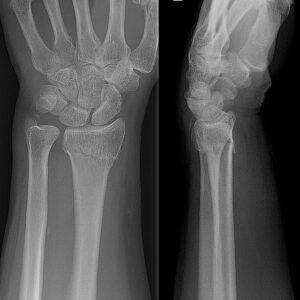Distal radial fracture is second most common fracture in older adults. Fractures are reduced in A&E department followed by POP application. Follow up arrange in fracture clinic for further management.
To determine the association between radiographic measures of reduction and patient outcomes after DRF in older patients
My Learning::
To determine the association between radiographic measures of reduction and patient outcomes after DRF in older patients
Multicentre randomised controlled trial.
Wrist and Radius Injury Surgical Trial (WRIST), an international, 24-site randomized clinical trial of DRF treatment in older adults.[1]
Trial included 166 patients aged 60 years or older with isolated distal radial fracture with displacement warranting surgical intervention after reduction attempt: dorsal tilt >10°, radial inclination <15°, or radial shortening >3 mm).
Enrolled patients were randomized to receive percutaneous pinning, external fixation with or without supplemental k-wire fixation, or internal fixation with volar plate. Those who did not wish to undergo surgery were treated with casting and were considered an observation group.
Follow-up care and rehabilitation and/or physical therapy were carried out per institutional standards at each site with 2 years of follow-up
Conclusion:
The results of our study suggest that radiographic measures of reduction are not associated with functional outcomes and patient-reported outcomes in older adults after distal radial fracture treatment.
Clinically, this finding implies that precise anatomic realignment of the wrist is not necessary for satisfactory outcomes.
Bottom line:
There is no need for re manipulation of distal radial fracture in A&E after adequate reduction with good technique, if radiological outcome is not satisfactory. The exception would be if the patient has any neuro vascular deficits.
These patients can be referred to fracture clinic for further management.
Reference:
- Chung KC, Cho HE, Kim Y, Kim HM, Shauver MJ, for the WRIST Group. Assessment of Anatomic Restoration of Distal Radius Fractures Among Older Adults: A Secondary Analysis of a Randomized Clinical Trial. JAMA Netw Open. 2020;3(1):e1919433. doi:10.1001/jamanetworkopen.2019.19433

